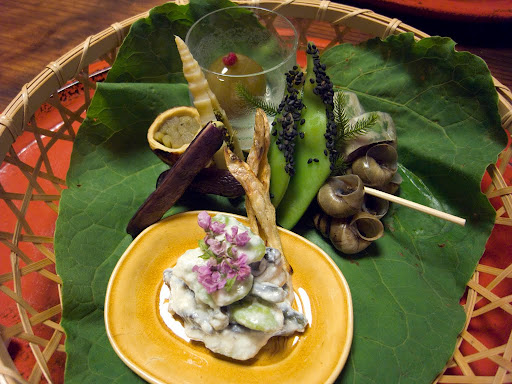Dear Mr. Nakahigashi:
I have been lucky to have traveled; profoundly experienced different cultures and lived in exciting cities; eaten wonderful meals, many of them which have had a long lasting effect, not only in my memory, but also on my philosophies and the way I live my daily life.
Every day Mr. Nakahigashi brings vegetables and fruits from the mountains near Kyoto. This eventually makes it to his daily dishes. In this case the wild ajisai (hortensia) flowers and their aroma were a sweet reminder of the season, right before the meal.
On June 30, 2010 my wife, her parents and I visited your restaurant. We had been in Kyoto for two days and had been enjoying the colors, sounds and nuances of this tsuyu (rainy) season. Your meal came as an encore to all our experiences, synthesizing into an edible form what tsuyu in Kyoto became to mean to us.
Saba sushi
As dishes arrived to our table on the second floor dinning room, your kind wife described each dish not only in the way that we could understand it from a culinary point of view, but also imagine how your curiosity and respect for nature has is a strong influence in your daily creations. Through your wife, we begin to know you intimately, although indirectly, and begin to construct a personal context around this meal.

Grilled Ayu (sweetfish)

Koi sashimi
Plate after plate the beauty of the food in front of us, or even the succulent, respectfully simple preparation of it became a backdrop for what the real focus of the dinner. I began to intimately experience your philosophies of life, and the harmony of your craft with humanity.

Kome no Hana (rice blossoming

This dish is a play of the seasonal Minazuki sweet which is traditiona

Oshi sushi, very strong fermented rice, almost blue cheese like. Accompanie

Vegetables and fish in broth

The Main dish: Rice.

Accompaniments to our rice

Even Koge (the layer of rice that is closest to the clay pot) is celebrate

Coffee, 蘇 ("So" is made with milk but it's not cheese, but it certainly tastes like cheese), and brown sugar sweets.
Your food had not only amazed my eyes and nourished my body. Through it you shed some light onto an unnoticed facet of person, which since that day, I have been working hard on rectifying. As we exited your restaurant you and your wife kindly walked us to our taxi. A loving warmth surrounded me as you both waved farewell. I waved farewell back to you.






No comments:
Post a Comment